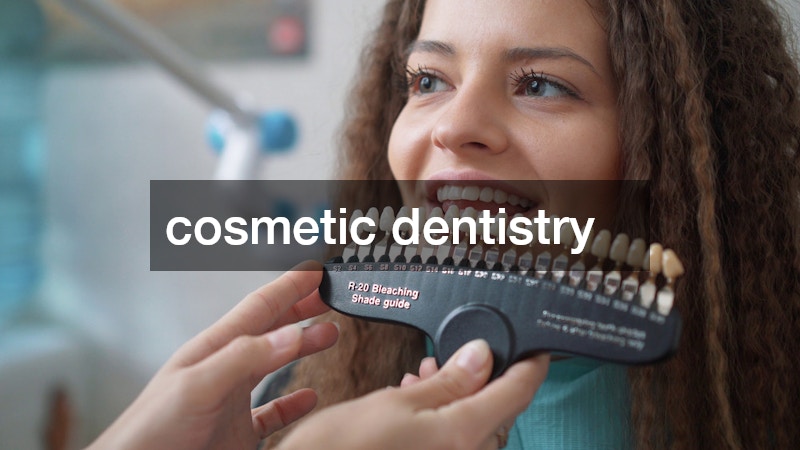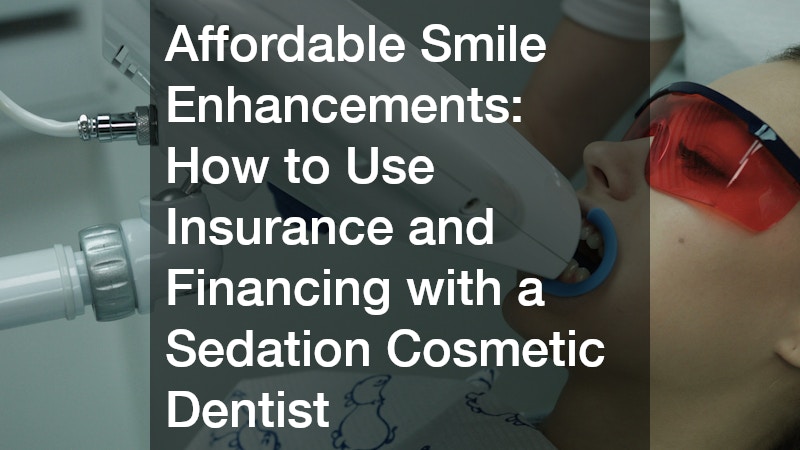
- Sedation cosmetic dentistry helps patients overcome fear and complete treatments comfortably.
- Insurance may cover parts of cosmetic procedures if they have restorative value.
- Sedation is sometimes covered when medically necessary or for lengthy procedures.
- Financing options like payment plans and HSAs can make cosmetic work more affordable.
- Multiple procedures under sedation can save time, reduce costs, and improve outcomes.
- Working with a sedation cosmetic dentist who accepts insurance simplifies billing and planning.
- A clear treatment plan with cost breakdowns helps you budget smarter and avoid surprises.

A beautiful, confident smile is often the first thing people notice—and one of the most valuable investments in your appearance and self-esteem. Yet for many, the path to a better smile is blocked by two common concerns: fear of the dentist and the cost of cosmetic treatments. Fortunately, working with a sedation cosmetic dentist who accepts insurance can make your dental transformation more comfortable and financially achievable.
Whether you’re considering veneers, teeth whitening, implants, or a full smile makeover, this guide will help you understand how to navigate insurance benefits, explore financing options, and make informed decisions about your oral health. By combining sedation dentistry with practical cost strategies, you can finally get the care you’ve been delaying, with far less stress than you imagined.
Understanding Sedation Cosmetic Dentistry
Sedation cosmetic dentistry refers to aesthetic dental treatments performed using sedatives to help patients relax during their procedures. While cosmetic dentistry focuses on enhancing the appearance of the smile, sedation ensures the process is calm and stress-free, especially for those with dental anxiety or complex treatment needs.
Sedation options commonly offered include:
- Nitrous oxide (laughing gas): A light sedative inhaled through a nose mask. It acts quickly and wears off rapidly.
- Oral sedation: A prescribed pill taken before the procedure. It helps reduce anxiety and induce drowsiness.
- IV sedation: Administered intravenously for moderate to deep sedation. Often used for longer or more invasive treatments.
Benefits of Sedation in Cosmetic Dentistry:
- Reduces fear and anxiety related to dental visits.
- Allows multiple procedures in a single appointment.
- Minimizes physical discomfort during lengthy treatments.
- Helps patients with sensitive teeth or strong gag reflexes.
If you’ve delayed treatment because of nervousness or fear, seeking a sedation cosmetic dentist who accepts insurance can help you feel safe, in control, and confident throughout your care.
How Dental Insurance Applies to Sedation and Cosmetic Procedures
Dental insurance can be tricky to navigate, especially when it comes to cosmetic procedures, which are often considered elective. However, if you work with a sedation cosmetic dentist who accepts insurance, you may be able to offset a portion of your costs, particularly if parts of the treatment are restorative in nature.
Understanding What Insurance Typically Covers:
Most insurance plans do not cover purely cosmetic treatments, such as:
- Teeth whitening
- Veneers
- Cosmetic bonding for aesthetic changes
However, procedures with restorative benefits may be partially or fully covered:
- Crowns (especially if the tooth is damaged or decayed)
- Implants (after tooth loss, with supporting documentation)
- Bridges and dentures
- Root canals
- Extractions
How Sedation May Be Covered:
Sedation is generally considered elective unless certain conditions apply. Your insurance might cover sedation if:
- The procedure is medically necessary (e.g., tooth extraction, implant placement).
- The patient has a documented history of severe dental anxiety or a diagnosed phobia.
- The appointment is expected to be lengthy or complex.
Maximizing Your Coverage:
To get the most from your plan when seeing a sedation cosmetic dentist who accepts insurance:
- Verify benefits before treatment by contacting your insurance company or letting your dentist’s office do it for you.
- Request a pre-authorization or pre-treatment estimate.
- Ask for procedure codes (CDT codes) to better understand what’s billable.
- Combine medically necessary and cosmetic work in the same session, if possible.
Questions to Ask Your Sedation Cosmetic Dentist About Insurance
Navigating dental insurance can be confusing without expert guidance. During your consultation, be sure to ask the right questions so you can plan your treatment and budget accordingly.
Key Questions to Ask:
- Do you accept my specific dental insurance plan?
- Will you submit insurance claims on my behalf?
- Can I get a written estimate with detailed cost breakdowns?
- Will any part of my cosmetic treatment be considered restorative and eligible for coverage?
- Is sedation likely to be covered based on the complexity of my treatment?
The answers to these questions can help you make informed decisions and avoid surprises when the bill arrives. A sedation cosmetic dentist who accepts insurance will usually have staff available to walk you through these details and communicate with your insurance provider directly.
Financing Options When Insurance Falls Short
While insurance can be helpful for procedures with medical value, most aesthetic treatments will require some out-of-pocket expense. That’s where dental financing comes in. A sedation cosmetic dentist who accepts insurance will often provide or partner with flexible payment solutions to help patients manage costs without sacrificing care.
Common Financing Solutions:
- In-House Payment Plans
- Typically interest-free.
- Split payments over several months.
- Easy approval through the dental office.
- Third-Party Financing
- Monthly installment plans with varying interest rates.
- Credit-based approval may apply.
- Repayment terms range from short to long-term.
- Dental Discount Plans
- Annual membership programs offering discounted fees.
- Not insurance, but helpful for uninsured or underinsured patients.
- May include sedation services at reduced rates.
- Health Savings Accounts (HSA) / Flexible Spending Accounts (FSA)
- Tax-free savings accounts for medical expenses.
- Often accepted for procedures with restorative elements or medical necessity.
- Can be used for sedation and surgery in some cases.
- Staged Treatment Scheduling
- Split your treatment into affordable phases.
- Prioritize restorative work first, then cosmetic.
- Helps spread out costs over time.
How Sedation Dentistry Saves Time and Money Long-Term
Choosing sedation for cosmetic dental work isn’t just about comfort—it can also be a smart financial move. Completing multiple procedures in fewer visits often leads to reduced overhead, fewer missed workdays, and better outcomes over time.
How Sedation Supports Efficiency and Value:
- Multiple procedures in one visit save on repeated setup, anesthesia, and appointment costs.
- Reduces dental emergencies by addressing problems proactively instead of delaying care.
- Prevents complications through earlier intervention.
- Boosts treatment compliance, especially for patients who avoid the dentist due to anxiety.
- Supports overall oral health, preventing more expensive problems later.
When you combine these benefits with insurance and financing options, working with a sedation cosmetic dentist who accepts insurance can be both a practical and life-changing decision.
Case Study: A Practical Example of Affording a Smile Makeover
Consider the case of a patient named “Maria,” a working professional who struggled with dental fear and avoided care for years. She needed a crown, several fillings, and wanted to improve the color and alignment of her teeth.
After finding a local sedation cosmetic dentist who accepts insurance, Maria was able to:
- Use insurance to cover the crown and fillings.
- Get sedation partially covered due to the extensive nature of the appointment.
- Finance her veneers and whitening treatments through a 12-month interest-free plan.
- Complete all her care in just two visits under oral sedation, saving time and avoiding repeated dental trauma.
Maria’s final bill was significantly lower than expected, and she walked away with a brand-new smile—and no lingering anxiety.
Budgeting Tips for Your Smile Enhancement Plan

Planning a cosmetic dental makeover doesn’t need to break the bank. With the right strategy, you can build a treatment plan that aligns with your goals and budget.
Practical Tips for Planning and Budgeting:
- Schedule a comprehensive consultation. Choose a sedation cosmetic dentist who accepts insurance and offers detailed treatment planning.
- Get itemized cost estimates. Separate cosmetic from restorative and sedation costs.
- Check your annual insurance maximum. Plan your treatment within the coverage limit or split treatment across benefit years if needed.
- Ask about promotional offers. Some practices offer seasonal discounts or bundled procedure pricing.
- Apply HSA/FSA funds early. Avoid losing unused balances at the end of the year.
Final Thoughts: A Confident Smile Is Within Reach
There has never been a better time to transform your smile, without fear and without financial overwhelm. By partnering with a sedation cosmetic dentist who accepts insurance, you can unlock access to high-quality, anxiety-free dental care that fits your lifestyle and your budget.
Modern sedation techniques make dental visits more comfortable than ever, and with careful planning, insurance coordination, and flexible financing, the cost doesn’t have to stand in your way.
Your dream smile is closer than you think. Don’t let cost or fear keep you from the care you deserve.

